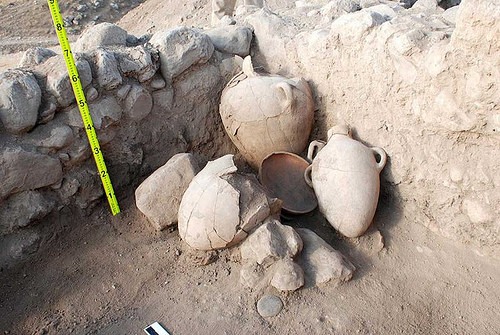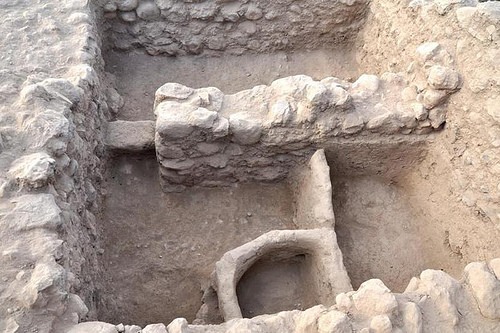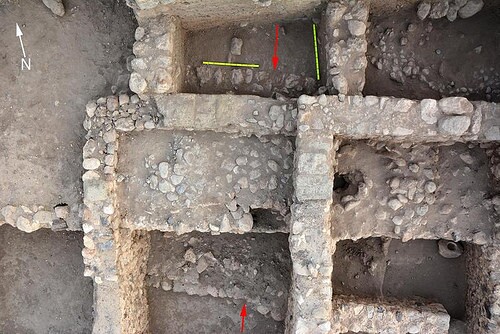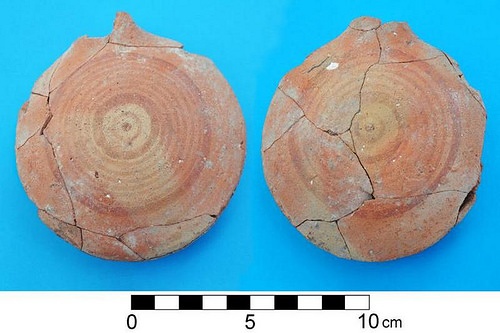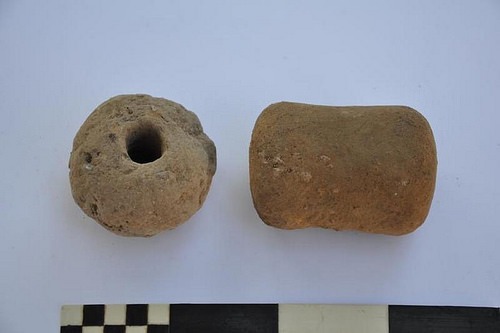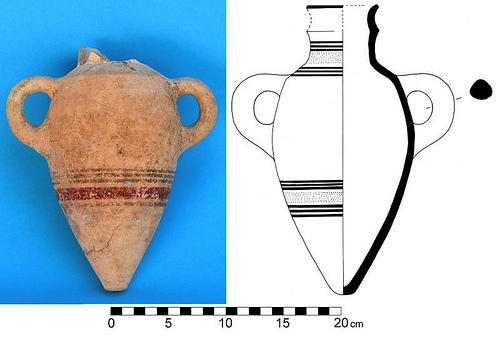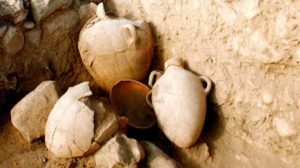
On a clear day, standing on the summit of this mound, one can see as far as the hills of Nazareth and Mount Tabor to the west, and major parts of the East Bank in Jordan. Today, it is a place where visitors can catch a commanding view of the countryside. For the ancients, thousands of years ago, it was an ideal location, situated as it was at the crossroads of trade routes, nestled within a rich and fertile natural environment that afforded robust commerce and agricultural production. Thus it is no wonder that people settled here so long ago. The evidence of their lives in this place go back as far as 3200 B.C.E—perhaps even earlier.
Those familiar with the location call it Tell Abu al-Kharaz, which means “the Mound of the Father of the Beads”. No longer occupied, it is an archaeological site, about 4 km east of the Jordan river in the Central Jordan Valley. Sometimes identified as the biblical Jabesh Gilead and as the burial site of King Saul, it can be counted among many such sites found within the borders of the Hashemite Kingdom of Jordan.
But this one drew some special attention in the press.
“We have evidence that culture from present Europe is represented in Tell Abu al-Kharaz,” stated excavations Director Peter Fischer of the University of Gothenburg, Sweden, in a press release.* What he means, of course, is ANCIENT Europe, and more particularly the cultures of the Aegean, ancient Cyprus, and what historians have often referred to as the Sea Peoples—a people thought to have originated in either western Anatolia or southern Europe, and more specifically the Aegean Sea region, and who journeyed by sea across the eastern Mediterranean and colonized Anatolia, Syria, Canaan, Cyprus, and Egypt at the end of the Bronze Age, well over 3,000 years ago.
Fischer has been directing the excavations here since 1989, now accompanied by Assistant Director Teresa Bürge of the University of Vienna. Their team has thus far uncovered the remains of a city that reached florescence three times over 5,000 years, featuring numerous structures, city walls and artifacts that tell a story of a fortified settlement spanning periods in the Early Bronze Age (3200 – 2900 B.C.E.), some new evidence of the Middle Bronze Age (2100 – 1550 B.C.E.), the Late Bronze Age (1600 – 1300 B.C.E.), and into and beyond the Iron Age (1200 – 600 B.C.E.).
“There is also evidence of post-Iron Age settlements, especially from Roman, Byzantine, Islamic and Mamluk periods,” report Fischer and Bürge.** But the comparatively sparse evidence for these later periods, to date, stand in stark contrast to that found for earlier periods.
View of Tell Abu al-Kharaz. Courtesy Peter M. Fischer and the University of Gothenburg
________________________________
The Iron Age Compound
The most sensational discovery emerged in 2009, when they encountered something unexpected. While cleaning and consolidating city walls to create a 3-dimensional reconstruction of the city’s defense system,
“the tops of the walls of an almost square structure, 4.4 by 4.2 meters in size (the outer dimensions), built on top of the Middle/Late Bronze Age city walls and protruding southwards, was exposed. This structure – later named Room 2 – turned out to be part of a particularly well-preserved architectural compound from the early Iron Age. The compound yielded numerous primary contexts, hundreds of complete pottery finds, tools, jewellery, and plenty of vessels containing well-preserved organic remains which were used for radiocarbon dating. As a result of these exceptional findings, the compound, which was destroyed during a catastrophic event, was further exposed from 2010 to 2012.”**
What they eventually uncovered was a multi-roomed, two-storey compound structure incorporated into the Iron Age city wall and measuring 60 meters in length with some of the walls still standing as much as 2.5 meters high. Dated to about 1100 B.C.E., it featured cells of square, standardized rooms with 3 by 3 meter dimensions, with nine pairs of rooms connected by standardized .6 by .75 meter wide doorways preserved to about 1.25 meters in height. (See image below.) The excavation debris indicated that its now-collapsed upper storey was constructed of mudbrick reinforced with wooden beams, twigs and straw. Excavation showed clear evidence that the ancients used the older Early Bronze Age wall to help provide a foundation to support the later Early Iron Age construction of the compound.
Reconstruction of Iron Age I two-storey compound (total length 46 m; reconstructed by M. Al-Bataineh). Courtey Peter M. Fischer and University of Gothenburg
________________________________________
The Iron Age I compound from above. Courtesy Peter M. Fischer and University of Gothenburg
______________________________________
The Iron Age I compound with 21 rooms exposed (46 m x 8 m). Courtesy Peter M. Fischer and University of Gothenburg.
_________________________________________
Iron Age I pottery found in situ in one of the compound rooms. Courtesy Peter M. Fischer and University of Gothenburg
______________________________________
An exposed room of the Iron Age I compound showing 2.5 m high walls preserved. Courtesy Peter M. Fischer and University of Gothenburg
________________________________________
Room 21 of the compound (the only room with a dividing wall) containing a clay-built grain silo. Courtesy Peter M. Fischer and University of Gothenburg
________________________________________
The Early Iron Age structures were built by the ancients upon the Early Bronze Age city wall (between red arrows). Courtesy Peter M. Fischer and University of Gothenburg
_______________________________________
“The architectural layout of the stone-walled spaces,” write Fischer and Bürge in their report, “gives a strong impression of centrally supervised town planning because of the standardized size of the rooms and entrances.”**
The compound, they report, is a unique find in two big ways. First of all, the architectural layout, particularly the curious cell plan of the structure, sets it apart from anything else they have found at the site. Moreover, “there is nothing like this structure in the immediately preceding Late Bronze Age Phase VIII or earlier Late Bronze Age phases at the site,” report Fischer and Bürge. “This specific architectural layout is also unique for the Transjordanian Jordan Valley or the remainder of Jordan in the early Iron Age.”** Secondly, a significant proportion of the artifacts found within the rooms, many of which were remarkably well-preserved, showed characteristics quite distinct from the standard Canaanite ware and assemblage that otherwise typified the site.
Clues to Foreign Connections
Among the artifact assemblages found within the compound cells were objects, as Fischer and Bürge describe, “which are exotic in comparison to the standard early Iron Age Canaanite repertoire.”** Those objects included finds like white-slipped vessels, such as a Philistine-style bowl standing on three loop handles, Philistine-style pilgrim flasks with cup-mouths, smaller flasks and a bichrome-decorated jug with a double handle clearly from Phoenicia, double pyxis with false spouts and basket handles—a type of ware found in the Aegean—alabaster vessels made of raw material that was imported, and a beautifully decorated Aegean/Philistine-style jug.
______________________________________
Early Iron Age Aegean/Philistine-style jug. Courtesy Peter M. Fischer and University of Gothenburg
_____________________________________
Early Iron Age Phoenician import. Courtesy Peter M. Fischer and University of Gothenburg
___________________________________
Early Iron Age pilgrim flask. Courtesy Peter M. Fischer and University of Gothenburg
_____________________________________
Phoenician-imported pilgrim flask. Courtesy Peter M. Fischer and University of Gothenburg
___________________________________
Were these finds made or brought by immigrants from Philistia, Phoenicia, or the Aegean?
Fischer and Bürge think it’s a real possibility, although they fully realize that there are other, equally tenable explanations.
“Even though the number of imports is considerable, all of these objects could be dismissed – if one insisted on doing so – on a variety of grounds as conventional imports which found their way to Tell Abu Kharaz by trade, and without their owners necessarily being associated with the homeland of these finds,” they state in their report.**
In the same breath, however, they point to other finds. “There are, however, groups of finds – unattractive as they may appear, but of vital importance to any society – which actualize the question of the ethnic origin of their owners, namely cooking pots, other plain-ware vessels used on a daily basis and textile production tools,” they write.** These were cooking pots of the characteristic closed-end style more typical of Philistia and the Aegean, and spool-shaped loom weights that are classic to the Aegean………..and their numbers were significant enough to reasonably suggest that this place may have been occupied, at least briefly, by a group of immigrants from the west — Sea Peoples who made their way across the Aegean and/or perhaps eastward from Philistia or southward from or through Phoenicia. They conclude:
“We put forward the possible scenario that people (females?) of Eastern Mediterranean or Philistine ethnicity arrived at Tell Abu Haraz in the course of intermarriage with indigenous people. This would explain the presence of both Aegean/Philistine- and Canaanite-related objects in the same compound. A consequence of these possible scenarios is that local people and foreigners lived in symbiosis. Another possibility could be that the Aegean/Philistine elements are related to mercenaries or craftsmen and their families who served and worked at the site. In this case it is also obvious that they lived in symbiosis with the local population because of the mixed find contexts from the same compound.”**
___________________________________________
Aegean/Philistine-style cooking pot. Courtesy Peter M. Fischer and University of Gothenburg
__________________________________
For comparison, Canaanite-style cooking pot. Courtesy Peter M. Fischer and University of Gothenburg
________________________________
Loom weights of unfired clay: standard Canaanite-typ (left); spool-shaped Aegean-type (right). Courtesy Peter M. Fischer and University of Gothenburg
_______________________________________
For Fischer, it all has implications for developing a deeper understanding of the world that existed at this time in the ancient Levant.
“What surprises me the most is that we have found so many objects from far away. This shows that people were very mobile already thousands of years ago,” he says.*
Mysteries remain, and much work needs to be done before a more conclusive assessment can be made about Tell Abu al-Kharaz in general. The 2013 excavations unearthed, for example, a curious vessel, bichrome-decorated in red and black with large vertical handles and a pointed base (see photo below). Their preliminary research has come up with no clear parallels thus far. But one thing is certain………it is an import.
_________________________________________
Courtesy Peter M. Fischer and University of Gothenburg
______________________________________
More information about Tell Abu al-Kharaz can be found at the project website.
______________________________________
Subscribe to Popular Archaeology Premium. Available on all laptops and mobile devices, and still the industry’s best value at only $9.00 annually.
___________________________________________
Travel and learn with Far Horizons.
____________________________________________
This richly illustrated issue includes the following stories: Recent findings shedding new light on the whereabouts of the remains of Philip of Macedon, father of Alexander the Great; how an archaeologist-sculptor is bringing bones of the dead back to life; archaeologists uncovering town life at the dawn of civilization; an exclusive interview with internationally acclaimed archaeologist James M. Adovasio about what makes the Meadowcroft Rockshelter prominent in the ongoing search for the first Americans; what archaeologists are finding at the site of the ancient city of Gath, the home town of the biblical Philistine giant, Goliath; and how scientists are redrawing the picture of human evolution in Europe. Find it on Amazon.com.





